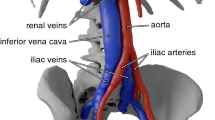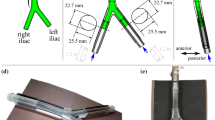Abstract
Pulmonary embolism is the third leading cause of death in hospitalized patients in the US. Vena cava filters are medical devices inserted into the inferior vena cava (IVC) and are designed to trap thrombi before they reach the lungs. Once trapped in a filter, however, thrombi disturb otherwise natural flow patterns, which may be clinically significant. The goal of this work is to use computational modeling to study the hemodynamics of an unoccluded and partially occluded IVC under rest and exercise conditions. A realistic, three-dimensional model of the IVC, iliac, and renal veins represents the vessel geometry and spherical clots represent thombi trapped by several conical filter designs. Inflow rates correspond to rest and exercise conditions, and a transitional turbulence model captures transitional flow features, if they are present. The flow equations are discretized and solved using a second-order finite-volume method. No significant regions of transitional flow are observed. Nonetheless, the volume of stagnant and recirculating flow increases with partial occlusion and exercise. For the partially occluded vessel, large wall shear stresses are observed on the IVC and on the model thrombus, especially under exercise conditions. These large wall shear stresses may have mixed clinical implications: thrombotic-like behavior may initiate on the vessel wall, which is undesirable; and thrombolysis may be accelerated, which is desirable.







Similar content being viewed by others
References
ANSYS Fluent. http://www.fluent.com
ANSYS Fluent theory manual
Barstad RM, Roald HE, Cui Y, Turitto VT, Sakariassen KS (1994) A perfusion chamber developed to investigate thrombus formation and shear profiles in flowing native human blood at the apex of well-defined stenoses. Arterioscler Thromb 14(12):1984–1991
Cheng CP, Herfkens RJ, Taylor CA (2003) Inferior vena cava hemodynamics quantified in-vivo at rest and during cyclic exercises using magnetic resonance imaging. Am J Physiol Heart Circ Physiol 284:1161–1167
Eriksson EE, Karlof E, Lundmark K, Rotzius P, Hedin U, Xie X (2005) Powerful inflammatory properties of large vein endothelium in vivo. Arterioscler Thromb Vasc Biol 25:723–728
Esclamado RM, Carroll WR (1999) The pathogenesis of vascular thrombosis and its impact in microvascular surgery. Head Neck 21(4):355–362
Grabowski EF (1995) Thrombolysis, flow, and vessel wall interactions. J Vasc Interv Radiol 6(6 Pt 2 Suppl):25S–29S
Harlal A, Ojha M, Johnston KW (2007) Vena cava filter performance based on hemodynamics and reported thrombosis and pulmonary embolism patterns. J Vasc Interv Radiol 18:103–115
Kalva SP, Chlapoutaki C, Wicky S, Greenfield AJ, Waltman AC, Athanasoulis CA (2008) Suprarenal inferior vena cava filters: a 20-year single-center experience. J Vasc Interv Radiol 19(7):1041–1047
Katsamouris AA, Waltman AC, Delichatsios MA, Athanasoulis CA (1988) Inferior vena cava filters: in vitro comparison of clot trapping and flow dynamics. Radiology 166:361–366
Khanafer KM, Bull JL, Berguer R (2009) Fluid-structure interaction of turbulent pulsatile flow within a flexible wall axisymmetric aortic aneurysm model. Eur J Mech B Fluids 28:88–102
Kroll MH, Hellums JD, Mcintire LV, Schafter AI, Moake JL (1996) Platelets and shear stress. Blood 88:1525–1541
Kudo FA, Muto A, Maloney SP, Pimiento JM, Bergaya S, Fitzgerald TN, Westvik TS, Frattini JC, Breuer CK, Cha CH, Nishibe T, Tellides G, Sessa WC, Dardik A (2007) Venous identity is lost but arterial identity is not gained during vein graft adaptation. Arterioscler Thromb Vasc Biol 27:1562–1571
Leask RL, Johnston KW, Ojha M (2001) In vitro hemodynamic evaluation of the Simon nitinol vena cava filter: possible explanation of IVC occlusion. J Vasc Interv Radiol 12:613–618
Leask RL, Johnston KW, Ohja M (2004) Hemodynamic effects of clot entrapment in the TrapEase inferior vena cava filter. J Vasc Interv Radiol 15:485–490
Lee P, Raizada A, Ciocca R (2009) Growing utilization of IVC filter placement from 2001–2005: analysis of NIS. Presented at the Society for Clinical Vascular Surgery 2009 Meeting, March 18–21, 2009, Fort Lauderdale, FL
Lowe GD (2004) Virchow’s triad revisited: abnormal flow. Pathophysiol Haemost Thromb 33:455–457
Lu PC, Lai HC, Liu JS (2001) A reevaluation and discussion on the threshold limit for hemolysis in a turbulent shear flow. J Biomech 34:1361–1364
Mackman N (2008) Triggers, targets and treatments for thrombosis. Nature (London) 451:914–918
Murphy EH, Johnson ED, Arko FR (2008) Evaluation of wall motion and dynamic geometry of the inferior vena cava using intravascular ultrasound: implications for future device design. J Endovasc Ther 15:349–355
Pope SB (2000) Turbulent Flows. Cambridge University Press, UK
Rahbar E, Mori E, Moore JE Jr (2011) Three-dimensional analysis of flow disturbances due to clots in vena cava filters. J Vasc Interv Radiol 22:835–842
Requarth JA (2011) Re: toward an optimal position of inferior vena cava filters: computational modeling of the impact of renal vein inflow with the Celect and TrapEase filters. J Vasc Interv Radiol 22(1):102–103
Singer MA, Henshaw WD, Wang SL (2009) Computational modeling of blood flow in the TrapEase inferior vena cava filter. J Vasc Interv Radiol 20:799–805
Singer MA, Wang SL (2011) Modeling blood flow in a tilted inferior vena cava filter: does tilt adversely affect hemodynamics? J Vasc Interv Radiol 22:229–235
Stein PD, Sabbah HN (1974) Measured turbulence and its effect on thrombus formation. Circ Res 35:608–613
Stewart SF, Robinson RA, Nelson RA, Malinauskas RA (2008) Effects of thrombosed vena cava filters on blood flow: flow visualization and numerical modeling. Ann Biomed Eng 36:1764–1781
Stoneham GW, Burbridge BE, Millward SF (1995) Temporary inferior vena cava filters: in vitro comparison with permanent IVC filters. J Vasc Interv Radiol 6:731–736
Swaminathan TN, Hu HH, Patel AA (2006) Numerical analysis of the hemodynamics and embolus capture of a Greenfield vena cava filter. J Biomech Eng 128:360–370
Turitto VT, Hall CL (1998) Mechanical factors affecting hemostasis and thrombosis. Thromb Res 92(6 Suppl 2):S25–S31
Wakefield TW, Caprini J, Comerota AJ (2008) Thromboembolic disease. Curr Probl Surg 45:844–899
Walters DK, Cokljat D (2008) A three-equation eddy-viscosity model for Reynolds-averaged Navier–Stokes simulations of transitional flow. J Fluids Eng 130(12):121401
Wang SL, Timmermans HA, Kaufman JA (2007) Estimation of trapped thrombus volumes in retrievable inferior vena cava filters: a visual scale. J Vasc Interv Radiol 18:273–276
Wang SL, Singer MA (2010) Toward an optimal position for inferior vena cava filters: computational modeling of the impact of renal vein inflow with Celect and TrapEase filters. J Vasc Interv Radiol 21:367–274
Wang SL, Singer MA (2011) Drs. Wang and Singer respond. J Vasc Interv Radiol 22(1):103–105
Zhang JN, Bergeron AL, Yu Q, Sun C, McBride L, Bray PF, Dong JF (2003) Duration of exposure to high fluid shear stress is critical in shear-induced platelet activation-aggregation. Thromb Haemost 90(4):672–8
Acknowledgments
The authors thank Professor James E. Moore Jr. for providing the vessel geometry used in this study. LLNL is operated by Lawrence Livermore National Security, LLC, for the DOE National Nuclear Security Administration under Contract No. DE-AC52-07NA27344.
Conflict of interest
The authors declare no conflicts of interest.
Author information
Authors and Affiliations
Corresponding author
Rights and permissions
About this article
Cite this article
Ren, Z., Wang, S.L. & Singer, M.A. Modeling hemodynamics in an unoccluded and partially occluded inferior vena cava under rest and exercise conditions. Med Biol Eng Comput 50, 277–287 (2012). https://doi.org/10.1007/s11517-012-0867-y
Received:
Accepted:
Published:
Issue Date:
DOI: https://doi.org/10.1007/s11517-012-0867-y




